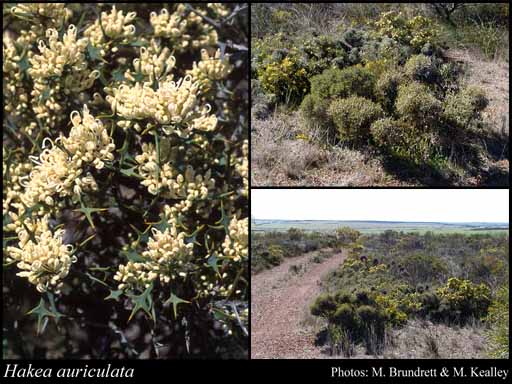- Reference
- Hooker's J.Bot.Kew Gard.Misc. 7:116 (1855)
- Conservation Code
- Not threatened
- Naturalised Status
- Native to Western Australia
- Name Status
- Current
Shrub, 1.5-2 m high. Fl. cream & pink, Jun to Oct. Yellow or white/grey sand over laterite or granite. Stony hills, breakaways.

Scientific Description
Shrubs, 1.5-2 m high; branchlets glabrous or hairy. Leaves alternate, 30-55 mm long, 8-36 mm wide, glabrous; lamina flat, clearly widest above the middle, once divided, pinnately divided or divided only at the apex, shallowly divided. Inflorescences axillary, cream or pink; pedicels 4-7 mm long. Perianth 5-7 mm long, glabrous; ovary glabrous; pistil 8-10 mm long, pollen presenter oblique, style glabrous. Follicles 15-25 mm long, 10-16 mm wide, corky tetrahedral projections (on external surfaces of fruit) absent; seed 1.7-1.9 mm long (including wing), 8-11 mm wide, the wing continuous or discontinuous, marginal, extending ± unequally down each lateral side. Flowers in June, July, August, September or October. Occurs in the South-west (SW) Botanical Province(s), in the Geraldton Sandplains (GS), Swan Coastal Plain (SWA), Avon Wheatbelt (AW) or Jarrah Forest (JF) IBRA subregion(s).
Distribution
- IBRA Regions
- Avon Wheatbelt, Geraldton Sandplains, Jarrah Forest, Swan Coastal Plain.
- IBRA Subregions
- Dandaragan Plateau, Geraldton Hills, Lesueur Sandplain, Merredin, Northern Jarrah Forest, Perth.
- Local Government Areas (LGAs)
- Carnamah, Chapman Valley, Coorow, Dandaragan, Gingin, Greater Geraldton, Irwin, Mingenew, Northampton, Swan, Three Springs, Victoria Plains.